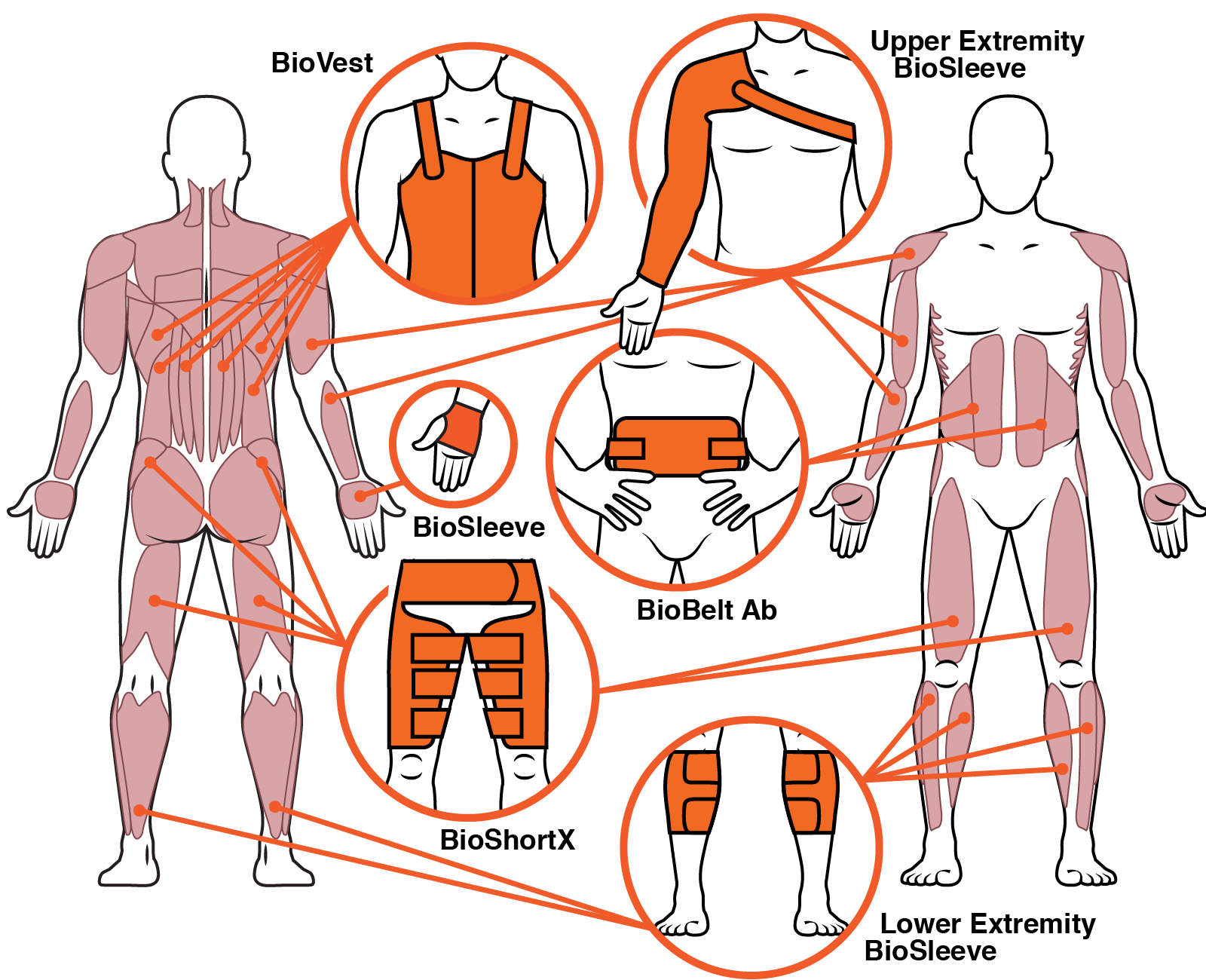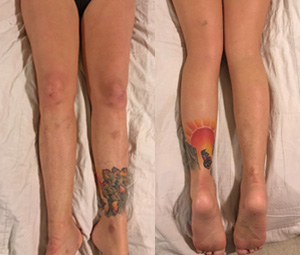
Wearable Therapy™ for Spinal Cord Injuries
Keeping your body healthy when you have a spinal cord injury is no small task.
Wearable Therapy™ can help with the daily exercises required to keep your muscles active, improve local blood circulation, and relax muscle spasms. And because it is wearable, you are freed up to engage in other activities that are important to you.
Taking care of your body doesn't have to be the only thing you do all day.
Wearable Therapy™ treats the effects of neurological conditions such as disuse muscle atrophy and muscle spasms in patients with spinal cord injury.
Wearable Therapy™ uses NMES electrical stimulation to repeatedly contract and relax muscles, which maintains muscle strength. By managing the contractions of the muscles, NMES can also calm erratic muscle spasms and restore a more natural state of relaxation.
In addition, the increased muscle activity causes blood to flow into the contracting muscle and surrounding area, increasing local blood circulation.
It is important to begin using Wearable Therapy™ as soon as possible after spinal cord injury in order to help prevent the loss of muscle mass.
Wearable Therapy™ is the most comprehensive system available for treating the effects of spinal cord injury. A Wearable Therapy®system can be designed for patients with paraplegia or complete quadriplegia.

Arms
Left Arm BioSleeve
deltoid
biceps
triceps
finger flexors
finger extensors
Right Arm BioSleeve
deltoid
biceps
triceps
finger flexors
finger extensors
Spine
BioVest
paraspinal muscles
quadratus lumborum
latissimus dorsi
BioBelt
abdominals
Hands
Left Hand BioSleeve
hand intrinsics
Right Hand BioSleeve
hand intrinsics
Legs
BioShorts
quadriceps
hamstrings
gluteals
Left Leg BioSleeve
dorsiflexors
plantarflexors
Right Leg BioSleeve
dorsiflexors
plantarflexors
Making Muscle Therapy Easier
Many of our patients have shared their stories with us. Stories detailing their struggle to balance the muscle therapy and pain management their bodies require with the time they need to pursue their interests and live life.
One father described his experience using an FES bike to stimulate his daughter's muscles. He told us the process of placing individual electrodes was arduous and it took one hour for electrode set up and another hour for take down. His daughter only received stimulation for 15 minutes each time they did it, which was only twice a week due to the complexity of the system. He was looking for a more effective way to keep her body in good shape and not disrupt her daily activities, including schooling.

We understand complex medical disabilities
We've heard countless stories of travel to and from the therapy facility taking two, three, even four times as long as the time they spend there.
Over and over, families share their concerns of being able to continue to afford the therapy they know they need.
Others are searching for a way to do muscle therapy at home...or away. They're looking for a portable solution they can take with them when they travel.
If tales of limited muscle therapy time, increasing costs, and complicated and inflexible procedures sound familiar to you, Wearable Therapy™ may be the solution you've been looking for.

Wearable Therapy™ Can Manage Pain Too
Many spinal cord injury patients also experience pain. In addition to providing muscle therapy, Wearable Therapy™ can help manage pain as well. It prompts the nervous system to suppress the transmission and perception of pain.
Wearable Therapy™ can be tailored to wherever your pain is, including lumbar, thoracic and cervical spine, hip, groin, shoulder, and upper and lower extremities.
Drew's Story
Drew was practicing a backflip in 2010 for the school musical at Walled Lake Central High in Michigan when the unthinkable occurred. Drew Clayborn, a 15-year-old sophomore, suffered a spinal cord injury that left him paralyzed.
Despite his injury, Drew continued to participate in marching band, finished high school, and went on to attend the University of Michigan.
Even while busy attending classes, he is still able to fit in daily workouts because Wearable Therapy® is conveniently done in his bed or wheelchair.

Multi-tasking is key
Drew is able to accomplish 3-5 hours of muscle therapy every day because he can do it while he does other things - studying, watching TV, posting to his blog, sleeping...whatever.
Wearable Therapy™ doesn't make Drew choose between completing his therapy and living his life. Wearable Therapy™ makes it possible for him to do both.

Drew now uses Wearable Therapy™ 3-5 hours per day to prevent muscle atrophy, manage muscle spasms, and improve local circulation.
Drew's legs look as good today as they did a decade ago.


Drew Clayborn is a Wearable Therapy™ user and advocate. We stand in strong support of this young man as he demonstrates to the world that the human spirit can overcome great obstacles.
Jesi's Journey
After her SCI, Jesi began using Wearable Therapy™ for the lower extremities. Because her legs are paralyzed, she does not have the ability to exercise them as she did before her accident so she relies on the Wearable Therapy™ suit to do this for her to keep her in the best possible health.
The Wearable Therapy™ suit helps her manage atrophy, spasms, and circulation by artificially stimulating her leg muscles. Amazingly, she accomplishes this at night when she sleeps. Her muscles get a full 8 hours of muscle therapy time before she wakes in the morning. This frees up her time to do the things she needs to do during the day, including competing in various extreme sports.

Managing Pain - in her own words
Jesi's active lifestyle is hard on all of her equipment so she has to send in her BioShorts from time to time for refurbishing. She's always very excited to have them back, but we'll let her tell you:
"The week I go without my shorts is the most miserable time with my SCI.
"The nerve pain and intense spasms didn’t really start until day 3. The burning pain in my legs was intense. I was crying, begging them to stop. I wanted my legs gone. I cannot even imagine living with this daily.
"These shorts have been life-changing for me. I almost cried when I was finally able to use them again! I am so grateful I’ve had them since the beginning.
"Thank you for everything you do! Seriously. I had no idea how much wearable therapy truly helped neuropathic pain in my legs until I have to go without it.
"I cannot imagine life without Axiobionics!!"

Watch Jesi demonstrate how she preps her Wearable Therapy to wear while she sleeps.
Jesi is an amazing young woman with an unequaled zest for life, never letting her physical condition get in the way of what she wants to accomplish.
She is an inspiration to all of us here at AxioBionics and to the many fans that follow her.
Indications for NMES:
- Retarding or preventing disuse atrophy
- Maintaining or increasing range of motion
- Re-educating muscles
- Relaxation of muscle spasms
- Increasing local blood circulation
- Prevention of venous thrombosis of the calf muscles immediately after surgery

Treatment for the Effects of Spinal Cord Injury
Wearable Therapy™ treats the effects of neurological conditions such as disuse muscle atrophy and muscle spasms in patients with spinal cord injury.
It is important to begin using Wearable Therapy™ as soon as possible after spinal cord injury to prevent the loss of muscle mass.
Wearable Therapy™ may be the right choice for you.

“The change was immediate.
"Since I began using the AxioBionics garments, I have had virtually no loss of muscle. I have very good muscle tone and minimal spasms.”
When asked what pieces of equipment he uses, Drew laughs and says, “All of them! I don’t have to wear any braces on my hands or feet though (to keep the muscles from contracting) because the garments exercise my muscles so well that my fingers and toes have never curled up.”
– Drew
